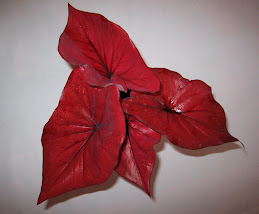
Caladium can be bought at stores in early spring, or online directly from the growers, which is my preferred way of obtaining them. The growers usually sell larger tuber than what is available in stores, and since they are shipped fresh, the tubers are usually more plumb with clearly visible growing eyes. This year, however, supply may be short due to the hurricanes in Florida late last year.
Producing more leaves
You may remember from our previous article Cutting and Pinching, part1 that dominant growing point will exert apical dominance over nearby surrounding buds suppressing them from growing. This is caused by a high concentration of the natural plant hormone called auxin in the primary growing point. This hormone will physically suppress the nearby growing points from developing. More buds are created by the plant as backup in case of damage to the main growing point (the terminal bud) but the auxiliary buds are not allowed to develop.
Behind the Scenes
This is a natural response aimed at protecting the caladium against damage by wind, animals or even a careless gardener (such as me!!). As long as the main growing point is intact, the caladium plant suppresses the other growing points which allow room for the terminal bud to develop into a leaf without having to worry about competition from other leaves. The reason is probably that as long as no damage is done to the plant, the development of one leaf is all that is needed to support the plant. Should the main growing point be damaged, several auxiliary buds will be prompted to grow by the changed hormone balance. Since the plant can only survive if has a leaf, in order to convert the sun's energy into food (i.e. photosynthesize), all efforts will be changed to concentrate on a new purpose: to grow many new leaves in the hope that at least one will survive.
The emphasis is no longer on creating one taller, larger, superior leaf, but rather as many leaves as practically possible. In this way the plant may actually survive, even if the damage continues, as long as at least one leaf remains.
Since the plant must make room for more leaves, these now tend to be smaller, and the leaf petiole not as tall. The reason for this is probably done in an effort to avoid the leaves shading for each other. The process requires more energy from the tuber, but the drain on the resources is an absolute necessity because without a leaf, the plant dies.
The response is quite ingenious and logical in my mind. As long as no damage has occurred the plant will grow as originally intended, but should damage occur, the plant now assumes that damage will continue and all efforts are put into the production of many leaves. The plant is not leaving it to chance that the damage is a one time event. If it has happened once, it assumes it will happen again; after all the caladium only has a limited growing season in which to create leaves, set seeds, and propagate.
Choosing Tubers to Scoop
To mimic the effect of a large tuber with many leaves, several smaller tubers can be planted together in a pot; you can even mix colors, but the grower can also prompt the caladium tubers to send up more leaves by a technique called de-eying, e.g. the removal of the terminal bud (dominant growing point) which will cause several nearby dormant auxiliary buds to start developing.
If you buy your tubers from local discount stores, the caladium is probably a dehydrated, hard, and compact where the eyes are not readily visible, whereas tubers shipped from the grower will have clearly visible growing points, some of which may already have started to elongate.
If you buy the fresh tubers from the growers, you may be able to simply break off the tooth-like growing points which will cause the auxiliary buds to grow. If not, you will instead have to 'scoop' the dominant eye.
It is done exactly as it sounds: with the tip of a knife, the dominant eye is scooped out. In the process, you have to be careful not to damage the surrounding dormant auxiliary buds which can be quite close. With a bit of experience, and taking your time, it is possible to identify the active primary and the dormant auxiliary growing points.
Scooping Caladium
Propagating Caladium
To propagate caladium, simply pull, or cut, the individual tubers apart (divide). Make sure to leave a few eyes on each division (see composite tuber above).
Note, while caladium tubers can handle considerable shade, to propagate tubers, try to give plenty of bright light or even half day sun in the north. Plants grown in deep shade will seldom generate enough energy to enlarge the tuber.































.jpg)

















